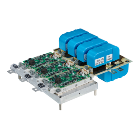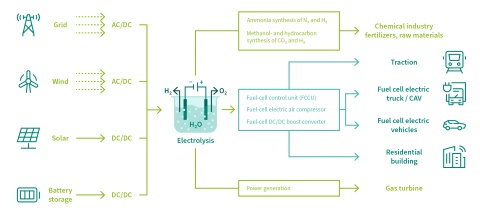Hydrogen electrolysis
Efficient electrolysis through comprehensive power conversion solutions

The supply of hydrogen for industrial use is a major global business, with electrical power demand to produce green hydrogen expected to reach up to 4500 GW by 2050. Current hydrogen production, however, is supplied almost entirely by fossil fuels, consuming around 6% of global natural gas and 2% of global coal supplies. In contrast, water electrolysis can generate “green” hydrogen by harnessing renewable energy sources, such as wind and solar power. Yet, this more sustainable process is currently only responsible for around 2% of worldwide hydrogen production.
Electrolysis produces hydrogen by using electricity to split water into its hydrogen and oxygen components. The process requires high levels of direct current (DC) supplied by power conversion systems. The design of this converter significantly affects the overall efficiency, reliability, and cost of the green hydrogen plant.
AC and DC-coupled power conversion topologies, using Infineon power semiconductors, are used in large hydrogen plants. AC inputs from the grid or wind-generated electricity sources must be converted to DC for the electrolyzer. DC inputs from photovoltaic or energy storage systems must also be converted to appropriate voltage levels. A variety of power conversion topologies can be found within an electrolysis plan, including:
AFE Rectifiers:
Active front-end rectifiers are IGBT-based converters and can be operated at unity power factors and have low levels of Total Harmonic Distortions (< 5%). For systems up to 250 kW, Easy and 62mm modules are economically suited for system outputs. For those above 250 kW, EconoDUAL ™ 3, XHP™, PrimePACK™, and IHM modules are an optimal choice.
Thyristors and Diodes:
Multi-pulse thyristor-based converters, usually 12-pulse or 24-pulse topologies, are popular for AC to DC power conversion because of their robustness, high efficiency levels, and high current density. Thyristor rectifiers are particularly useful in high-power applications (>1 MW). High system power (>50 MW) can be efficiently realized through the interaction of several high-power thyristors and diode discs.
Buck Boost / DAB:
Buck-type choppers and Dual Active Bridge are often used as the rear stage of thyristor or diode rectifiers with higher power factors across a wide operational converter range.
Boards & Designs

REF-CAV250KMT7INV

Simulationstools
IPOSIM – Infineon power simulation tool

Simulate ONLINE - IPOSIM System level Simulation Example - 3 Phase 2 Level Active Front End Rectifier using module FF1800R17IP5

Simulate ONLINE - IPOSIM System level Simulation Example - B6 Controlled Rectifier using module T4771N


REF-CAV250KMT7INV

IPOSIM – Infineon power simulation tool

Simulate ONLINE - IPOSIM System level Simulation Example - 3 Phase 2 Level Active Front End Rectifier using module FF1800R17IP5

Simulate ONLINE - IPOSIM System level Simulation Example - B6 Controlled Rectifier using module T4771N

Loggen Sie sich bei myInfineon ein, um alle verfügbaren Dokumente anzuzeigen
-
The importance of power conversion technologies in the production of green hydrogen
EN
CN
JA
01_00 | 2024-05-02 | pdf | 1.3 MB
-
Green Hydrogen: Efficient electrolysis through comprehensive power conversion solutions
EN
01_01 | 2024-06-10 | pdf | 2.9 MB
-
Platform Power Conversion solutions for hydrogen electrolysis
EN
01_00 | 2024-06-07 | pdf | 1.7 MB

Our whitepaper examines key growth drivers in the hydrogen market, highlighting the essential Power Conversion System (PCS) for electrolysis. It introduces standard electrolysis plant layouts and power conversion topologies. Infineon's leadership in power semiconductors enables a diverse PCS design portfolio. The conclusion offers insights into Infineon's product range and technological expertise.
Podcast4 Engineers - Hydrogen deep dive with Varun and Nils
As the significance of hydrogen energy continues to rise, we delve into its production process, specifically through electrolysis. Join our experts Varun Raghunath and Nils Przybilla in this episode as they explain what hydrogen electrolysis is and how power electronics help make it possible.
Podcast4 Engineers - Hydrogen on the horizon with Nils and Varun
From grey to green to blue, the spectrum of hydrogen reveals surprising color. Join our technical experts Nils Przybilla and Varun Raghunath in this episode as they explain why hydrogen is everywhere right now and how green hydrogen could change the way we think about energy.
Multi-MW rectifiers for efficient electrolysis
Video of photorealistic, digital 20 MW rectifier container in real-time 3D. The video shows a demo of a modular rectifier cabinet and the individual components for efficient electrolysis . Plug and Play for reliability in supply chain.
Power semiconductors for green hydrogen
Green hydrogen is produced in a CO2-neutral manner by utilizing electrolysis processes powered by renewable energies such as wind and solar. Power semiconductors make the production of green hydrogen possible. Gain insights into AC- and DC-coupled electrolyzer applications and learn about Infineon's best-in-class semiconductor solutions.
Webinars
Webinar: Platform power conversion solutions for hydrogen electrolysis
With this webinar, you will understand the comprehensive set of requirements that need to be met by power electronics engineers. The webinar will present a platform approach by which common design elements can be used to create various power conversion systems to accommodate all system requirements. The session will further include simulations and links to them for more specific designs.
How to design a power conversion platform solution for hydrogen electrolyzers
In this training we explore the fundamentals of green hydrogen production and the pivotal role of electrolyzer technologies in this growing sector. You will gain insights into a platform-based design approach for efficient power conversion in hydrogen electrolysis. Delve into the essentials of green hydrogen production to comprehensively understand this transformative industry. Discover the diverse requirements of electrolysis plants, including technology, voltage, current, and plant configuration. Stay tuned to learn more!
Green Hydrogen: Efficient Electrolysis through Comprehensive Power Conversion Solutions
Top 6 FAQs. Nutzen Sie die obenstehende Suchleiste für mehr Treffer.
Technischer Support
Der beste Weg, unsere Spezialisten zu erreichen, ist unsere Developer Community https://community.infineon.com
Unsere Spezialisten moderieren die Community, um sicherzustellen, dass alle Fragen schnell und präzise beantwortet werden, entweder von anderen Mitgliedern der Community oder von unseren eigenen Ingenieuren.
Wenn Sie unseren "direkten Kanal" bevorzugen, stellen Sie Ihre Anfrage bitte über unser Support Portal.
Dies ist ein direkter Weg, um schnell und einfach Unterstützung für Ihre Anliegen zu erhalten.
Um sich zu registrieren, klicken Sie bitte oben rechts auf der Infineon-Homepage auf "Registrierung für myInfineon" und folgen Sie den Anweisungen.
Um von zusätzlichen Vorteilen zu profitieren, empfehlen wir Ihnen, Ihre Firmen-E-Mail-Adresse zu registrieren.
Um sich einzuloggen, klicken Sie bitte auf "Login bei myInfineon".
Wenn Sie auf den Link "My Cases" klicken, werden Sie zum Kundenportal weitergeleitet.
Sie können den Link auch direkt aufrufen über: https://mycases.infineon.com.
Bei Fragen wenden Sie sich gerne an unsere Hotline unter: https://www.infineon.com/call
Mehr lesen
Partner für Software, Hardware, Dev-Tools, Services, Support
Die Partner von Infineon bieten Produkte und Dienstleistungen an, die unsere Lösungen ergänzen, um Ihre Entwicklung und Markteinführung zu beschleunigen. Sie können Sie hier finden: https://www.infineon.com/partnerfinder.
Mehr lesen
Gehäuseinformationen
Die Gehäuseinformationen finden Sie auf unserer Homepage. Bitte beachten Sie, dass diese in die Kategorien „Leaded and Through-hole“, „Surface Mounted Devices“ und „Special Packages“ unterteilt sind. Unter dem jeweiligen Punkt finden sie alle relevanten Gehäuseinformationen.
Mehr lesen
Verarbeitungshinweise
Informationen zu Reflow-Profil, Löttemperatur, Lötprofil und weitere Verarbeitungshinweise für die meisten diskreten Produkte sind in der Application Note aufgeführt.
Unter https://www.infineon.com/packages finden Sie das Dokument "General Recommendations for Assembly of Infineon Packages" im Abschnitt "Downloads".
Information zu TO-Gehäusen finden Sie unter https://www.infineon.com/assembly
In Bezug auf den ESD-Schutz erfüllt Infineon vollständig die IEC 61340-5-1.0-5-1.
Mehr lesen
Design-In-Unterstützung
Wir bieten Ihnen Design-in-Unterstützung für Ihre Anwendung.
Sie finden den Infineon Solution Finder unter https://www.infineon.com/solutionFinder
Hier haben Sie die Möglichkeit, sich mit den von Ihnen gewünschten Parameterwerten die passenden Produkte anzeigen zu lassen.
Mehr lesen
Simulation Parameter/SPICE-Modelle
Bitte besuchen Sie unseren Simulations Model Finder im Internet unter
https://www.infineon.com/simulation
Bitte wählen Sie dort "Simulation Models (SPICE, S-parameters, SABER)" aus.
Sollten Sie Ihr gesuchtes Model dort nicht finden können, stellen Sie bitte Ihre Anfrage über den Button "click to request model" auf der rechten Seite.
Infineon verwendet ausschließlich Spice und Sabre Models. Bei diesen handelt es sich um einen allgemein akzeptierten Standard, der alle Anforderungen an Simulationsmodelle erfüllt.
Mehr lesen





